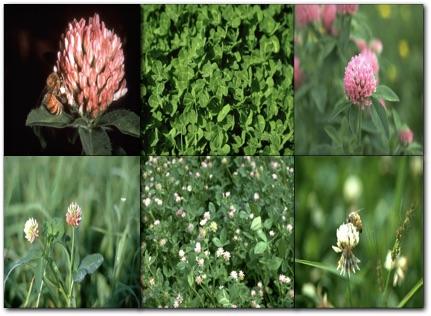
CLOVER TRAITS VARY
Forage legumes exhibitvaluable attributes including biological nitrogen fixation, extension of the grazing season, and improvement of forage quality and animal performance. In beef cattle production, clovers are the most widely used forage legumes. Various clovers have unique traits that determine the feasibility of growing them in different situations.
Annuals Versus Perennials- Annuals germinate, make their growth, and die in twelve months or less. Annual clovers suited to be grown in the South include arrowleaf clover, balansa clover, ball clover, berseem clover, crimson clover, and persian clover. Perennials have the potential to live more than one year on suitable sites and under proper management. White clover is a true perennial that can live for several years. Red clover is categorized as a biennial (can live two years).
However, in many areas in the Deep South, perennial clovers will not live through the summer, especially on drought-prone sandy soils, although red clover can be useful as a productive annual. Annual legumes are generally used in overseeding bahiagrass or bermudagrass or for planting in a prepared seedbed, often in mixtures with annual ryegrass and/or small grains.
Perennial clovers are usually grown with perennial grasses. White clover or red clover are well suited to be planted in tall fescue, dallisgrass, or orchardgrass pastures. White clover is more tolerant of close grazing than is red clover, but is not as tolerant of shading by grasses. As a result, white clover is widely used in many continuously and/or closely grazed pastures. Red clover works well in pastures that are rotationally stocked, and is an excellent companion to fescue, orchardgrass, dallisgrass, or johnsongrass in hay fields.
Moisture Requirements- Arrowleaf clover and crimson clover perform best on well-drained soils. Red clover is not well suited to extremely drought-prone soils, but does well on moderately drained to somewhat poorly drained soils. White clover, balansa clover, berseem clover, and persian clover do best on moist to poorly drained soils. Ball clover is widely adapted, but is also best suited to moist, heavy soils.
Soil Requirements- Legumes are sensitive to low levels of phosphorus and potassium, so these nutrients should be applied according to soil test recommendations. Most clovers are best suited to be grown on sites where the soil pH in the range of 6.0 to 7.0. Berseem clover, ball clover, persian clover, and red clover can tolerate a soil pH as high as 8.0.
Growth Distribution- Of the clovers mentioned, crimson clover makes the earliest spring growth, with most production coming in March and April. Ball clover is slightly later. Arrowleaf clover, balansa clover, and berseem clover make most of their growth in late April and May, and may provide some growth in early June. Red clover and white clover make some growth in early April, and growth may extend well into summer if soil moisture is available (especially in the case of red clover). Plants of red clover and white clover that live through the summer can make significant forage growth in autumn.
Some Traits Of Selected Clovers Often Grown In The Southern USA*
| Clover | Common Use | Relative Maturity | Suitable Drainage | Cold Tolerance** | Reseeding Ability |
| Arrowleaf | Grazing/Hay | Late | Good | Good | High |
| Balansa | Grazing/Hay | Late | Fair | Good | High |
| Ball | Grazing | Medium | Fair | Good | High |
| Berseem | Grazing | Late | Poor | Poor | Low |
| Crimson | Grazing | Early | Good | Good | Fair |
| Persian | Grazing | Medium | Poor | Fair | High |
| Red | Grazing/Hay | Late | Good | Good | Low |
| White
|
Grazing | Late | Poor | Good | High |
*Adapted from Dr. Rocky Lemus, Mississippi State University Publication Number P3153, and from Dr. G.W. Evers, Preferred Soil Types For Legume Species, Texas A & M University Technical Report 92-1
**This refers to general cold tolerance of these clovers in the Deep South. Some varieties within a species are more cold tolerant than others, especially in the case of Balansa, Berseem, and Crimson
__________________
Conclusion- Clovers have much to offer forage-livestock producers, but because traits of various species are quite different, it is essential to plant a given clover on a site and in a situation where it is known to be well suited. In addition, precision with establishment is necessary. Seed must be inoculated with the proper nitrogen-fixing bacteria (most seed commercially available is pre-inoculated). Attention to detail with regard to seeding rate, planting date, and seeding depth is required.
A common reason for stand failure results from seed being planted too deeply. Because clover seed is small and dense, it will often settle and end up too deep in the soil. For this reason, a firm seedbed is needed. A prepared seedbed should be firm enough that a footprint should make no more impression in the soil than the sole of a shoe (about ½ “).
__________________
Foraging Ahead is a column presented by Ragan & Massey and written by Dr. Don Ball, Professor Emeritus at Auburn University. Dr. Ball is one of the authors of the popular book “Southern Forages,” which can be found via a computer search that uses the words, “Southern Forages, The Fertilizer Institute”
